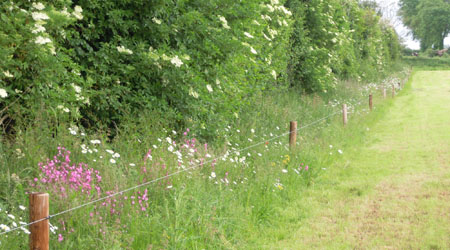Field Margin
Definition
Field margins are the areas between the crop and the field boundary and in most cases they occur adjacent to hedgerows.
The field margin is often overlooked as a habitat as it is regarded as part of the hedgerow. However, having a wide field margin beside a hedge will provide multiple benefits of food and shelter for much of our declining farmland biodiversity. The tendency to maximise land use has led to many field margins becoming non-existent with the crop now growing right up to the hedgerow border.

Creation
Creating a field margin is quite simple – it means moving the crop (usually grass, cereals or brassicas) out from the adjacent habitat (typically a hedgerow).
The BRIDE Project margin width recommendation is a minimum of 2m from the base of the hedgerow.
In a grazing situation, the hedgerow should be fenced off from the grass crop, so repositioning the wire fence 2m from the base of the hedgerow is all that is required.
In a tillage situation, commence sowing the crop 2m out from the base of the hedgerow.
The main difficulty involved in creating this habitat is the change of mind-set needed by farmers to change the land use in this small area from food production to biodiversity improvement.
Management
•It will be important to flail this margin every year (Sept. 15th to Feb.28th) to cut back the vegetation and prevent the hedgerow from encroaching onto the field margin. Cutting the ground vegetation will allow light down to ground level and thus encourage wild flowers to germinate the following year.
•Allowing livestock to access it (Sept, 15th to Feb. 28th) will also be beneficial. However, this may not be practical.
•It is very important when spreading fertiliser, to shut off the disc on the hedgerow side to prevent fertiliser from reaching the field margin – wild flowers will not thrive in nutrient-rich soil and wasting fertiliser in this area is costly to the farmer.
•Apart from improving biodiversity, perhaps a more important reason to increase the field margin width is to reduce the need for chemical control of vegetation by allowing a hedgecutter to control vegetation near an electric fence.
Benefits
As most of the cropping area on modern farmland does not contain high levels of biodiversity, the importance of the field margin is often overlooked.
Pollinator and insect numbers continue to decline, but the creation of field margins that contain wildflowers and vegetation cover will help to reverse these declines.
Bird species such as Yellowhammer and Willow Warbler nest on or close to the ground in thick vegetation so having a wide field margin will be of huge benefit to these species. Barn Owls and Kestrels depend on small mammals such as field mice, voles, rats and shrews for food and this habitat is where they occur most frequently.
